What is a Pergola and What is It Used for?
by Simmy Parker
The purpose of this article is to define what a pergola (also called perugola, or pergula ) is, what it is used for, and to distinguish it from some of its architectural garden-dwelling cohorts, including arbors and gazebos.
To kick things off, here is a picture of a pergola just to provide a visual reference.
So, the above example is what you might call a "typical" pergola. Why? Because it has four sturdy beams holding up the structure itself, including crossbeams with a stylish lattice across the top.
This pergola isn't enclosed, and, as it has a more minimal structure, it almost seems to have an "unfinished" look, depending on how you look at it.
The size of your ordinary garden-variety pergola is fairly large, spacious both vertically and horizontally, and rectangular. The space underneath, defined by the pergola, opens up many possibilities.
The lattice at the top, where the cross beams intersect, is not strictly necessary. It can simply have cross beams going one way without the lattice, with some sort of covering, like this:
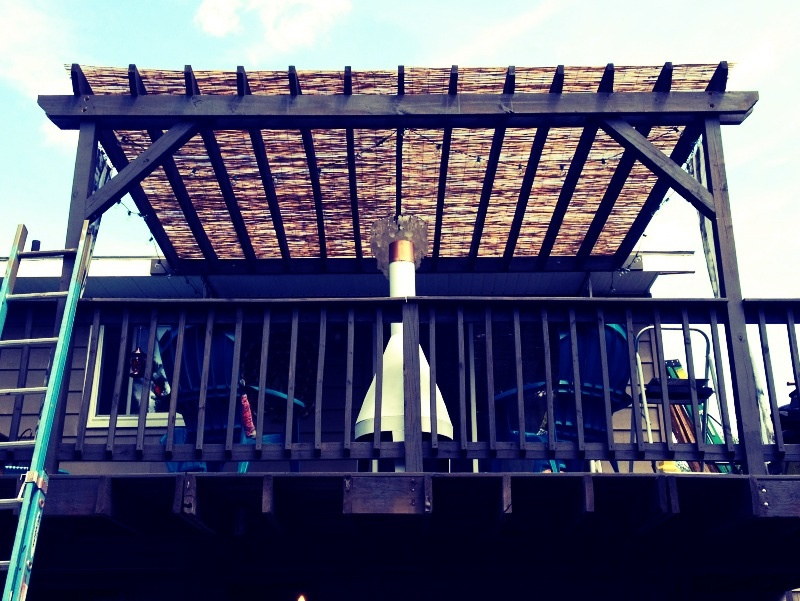
As you can see from the example above, pergolas can be elevated off the ground, so long as they have a surface to sit on.
Visually, pergolas are usually large enough to be striking when people see them, drawing their attention visually, and, aesthetically, they can come in many different designs and colours.
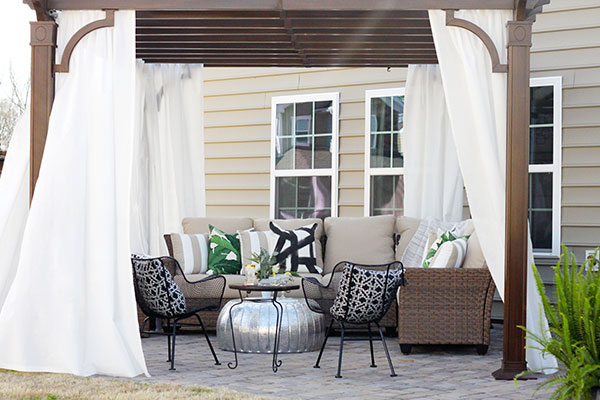
Contents
- What Is a Pergola and What Are Its Main Components ?
- The Purpose of a Pergola
- Pergola / Pergula / Perugola / Projecting Eave
- The Function of a Pergola
- The Different Types of Pergolas Available on the Market Today
- The Many Benefits of Owning a Pergola
- How to Install a Pergola in Your Backyard or Garden
- The Best Ways to Use Your Pergola to Get the Most Out of It
- Pergolas Vs. Gazebos and Solariums
- Pergolas Vs. Arbors
- Conclusion (For Now…)
Pergola Infographic | Infographic about Types of Pergolas and Facts
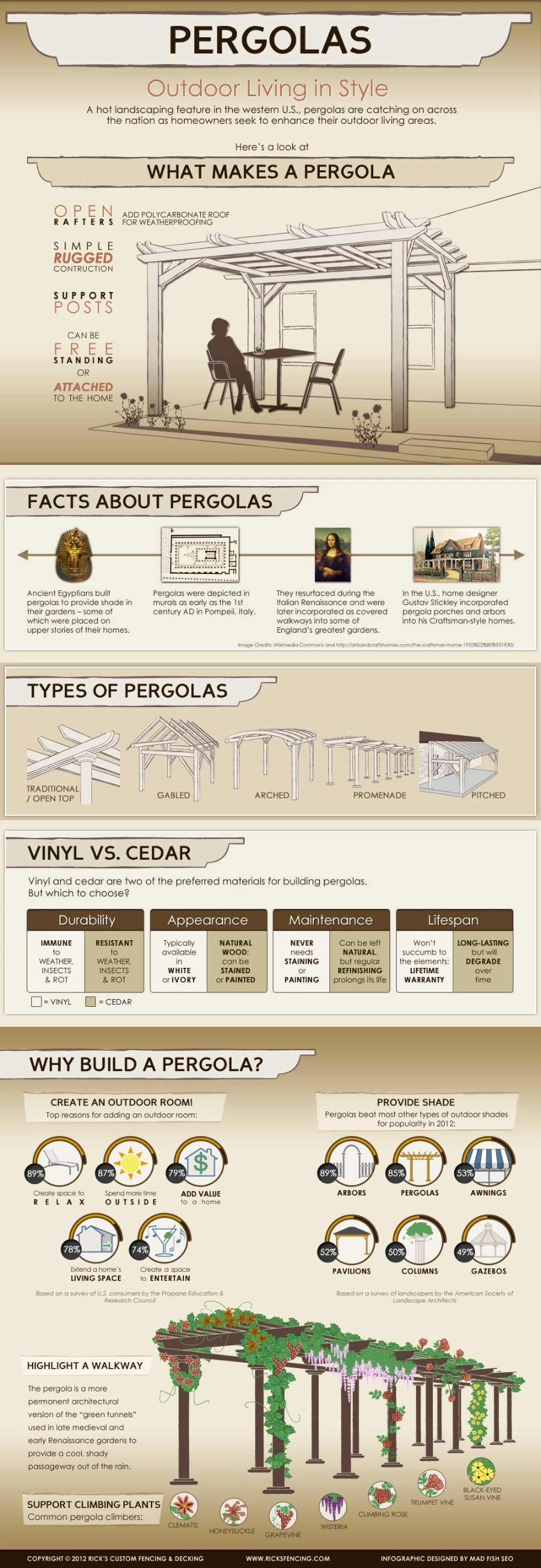
Photo Credit: here
What Is a Pergola and What Are Its Main Components ?
if you plan to buy a pergola, go here for all the choices.
The Definition
A pergola is an outdoor structure that consists of columns supporting a roof, typically made of beams and rafters. The roof may be open or covered. Pergolas are often used as garden features or as walkways between different areas of the garden.
The Main Components
The main components of a pergola are the posts, beams, rafters, and purlins. The posts support the beams, which in turn support the rafters. The purlins are horizontal members that help to stabilize the structure.
Materials for Pergolas
Pergolas can be made from a variety of materials, including wood, metal, and PVC. Wood is the most common material used for pergolas, as it is easy to work with and provides a natural look. Metal pergolas are also popular because they are durable and require little maintenance. PVC pergolas are a more affordable option, but they are not as sturdy as wood or metal structures.
The Purpose of a Pergola
The purpose of a pergola is just to provide an area for you and your family / friends to mingle in. You can choose whether you want to use it as an area to entertain, or if you want it to be a more private area to relax in, which can act as a respite from the world.
Curtains can help with this, as shown above. Once you have the pergola set up, that's when the real creativity comes in.
Your average 10 x 18 foot pergola creates a space that would be large enough to fit, say, a hot tub in, or some sectional furniture, creating a space in which you can luxuriate.
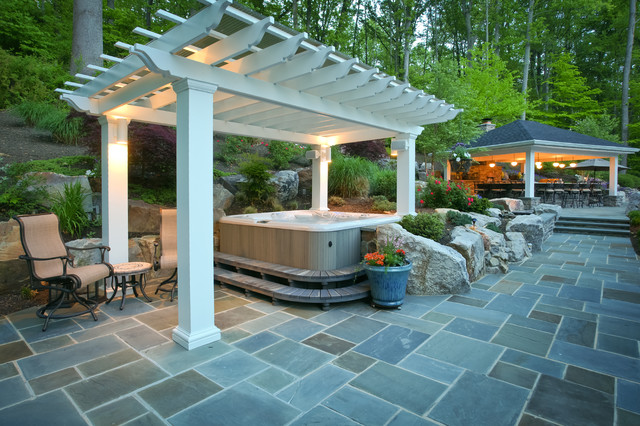
Of course, you won't get a lot of shelter under a pergola from the elements, like wind, sun, or rain, but you may not want that, as the idea is for it to be open, and allow for these elements to be part of your experience.
When choosing a pergola, it is important to consider its purpose. If you want an outdoor structure that will provide shade, then a covered pergola would be a good choice. If you want a structure that will add visual interest to your garden, then an open pergola would be a better option.
Pergola / Pergula / Perugola / Projecting Eave
The word pergola comes from the Latin word "pergula", which means "projecting eave".
Now, we all know eaves as being that part of a roof on our homes and sheds which generally projects out from the wall it sits atop, to create either a slight or pronounced overhang, allowing for rain to fall over the edge, away from the vertical walls of the structure in question.
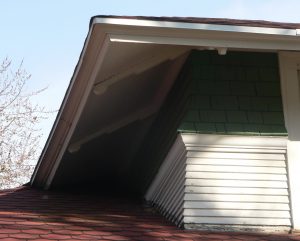
Except, hold on a minute. Rain doesn't just pour over the edge of most homes' roofs. Most houses, of course, have eavestroughs installed as well, which are gutters that are attached to our eaves that essentially catch and then channel water away from buildings at the ground level, so that the water doesn't just pour directly over the edge of our roofs.
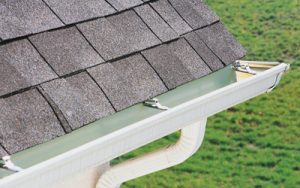
Eaves also create a little bit of extra shade for any given home or structure, and can create an alcove area for animals, birds, and insects. Some people are ok with this. Others are not.
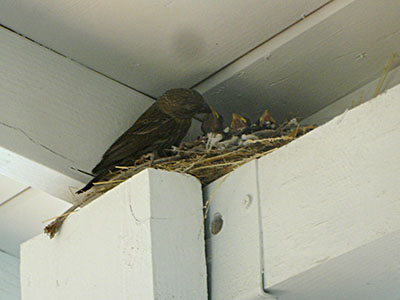
The Function of a Pergola
Now, it is interesting that a pergola should be based on the idea of an eave, because as a structure on it's own, it doesn't really have any eaves to speak of.
When we look at a typical pergola, it has a minimum of four support beams (often there are more), which can be made from materials like wood or stone, and then cross beams overtop to form a lattice, but no solid roof.
Here's a pergola made from bamboo, to give a little bit of a south Pacific feel.
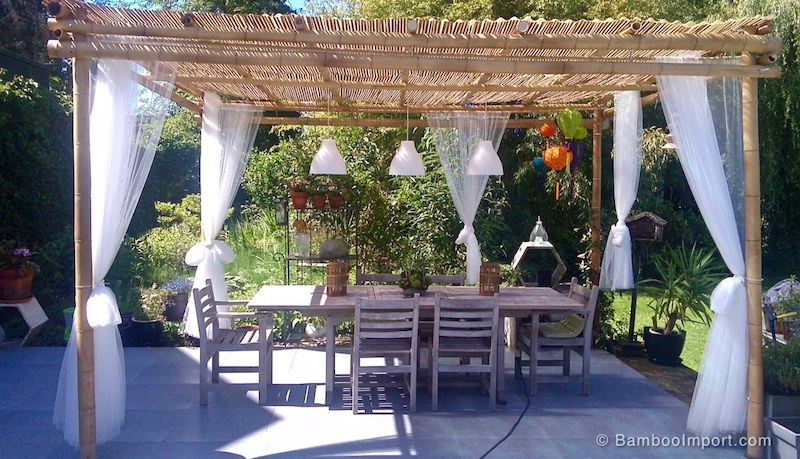
The idea, generally speaking, is that we sit under a pergola where we can relax and / or socialize, and it provides us with a designated area to do so, and yet, it need not have anything shading us from the sun or rain in terms of a solid roof.
The Different Types of Pergolas Available on the Market Today
When it comes to adding a pergola to your home, you have several different options available to you. Here is a look at some of the different types of pergolas that you can choose from:
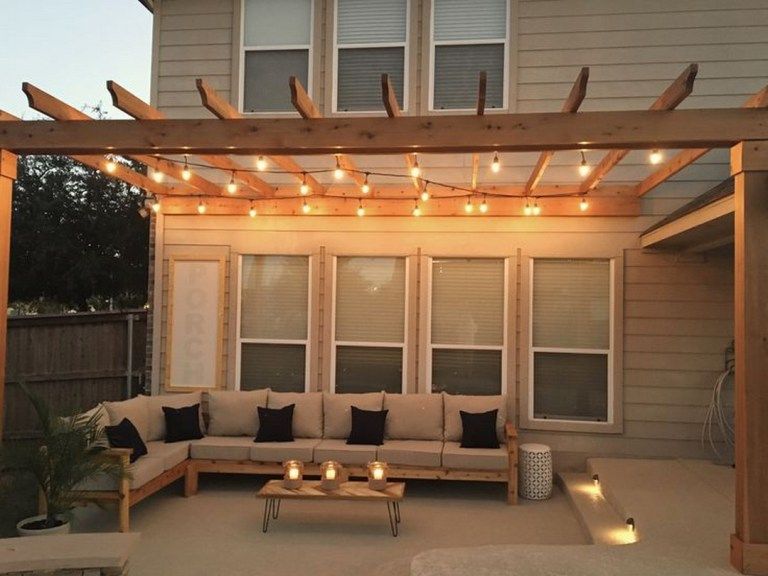
The Traditional / Open Top Pergola
A traditional or open top pergola is a free-standing structure that is supported by four or more columns. The roof of a traditional pergola is typically open, allowing sunlight and rain to filter through. Traditional pergolas are often used as outdoor gathering spaces, providing shade and protection from the elements. Open top pergolas can be constructed with a variety of materials, including wood, metal, and stone.
The Gabled Pergola
A gabled pergola is a type of pergola that has a peaked roof, making it ideal for providing shade and protection from the sun and rain. While most pergolas are rectangular or square in shape, a gabled pergola has an additional triangular section at the top, giving it its distinctive look. Gabled pergolas can be made from a variety of materials, including wood, metal, and vinyl, and can be customized to match the style of your home. If you're looking for a stylish and functional addition to your outdoor space, a gabled pergola is a great option.
The Arched Pergola
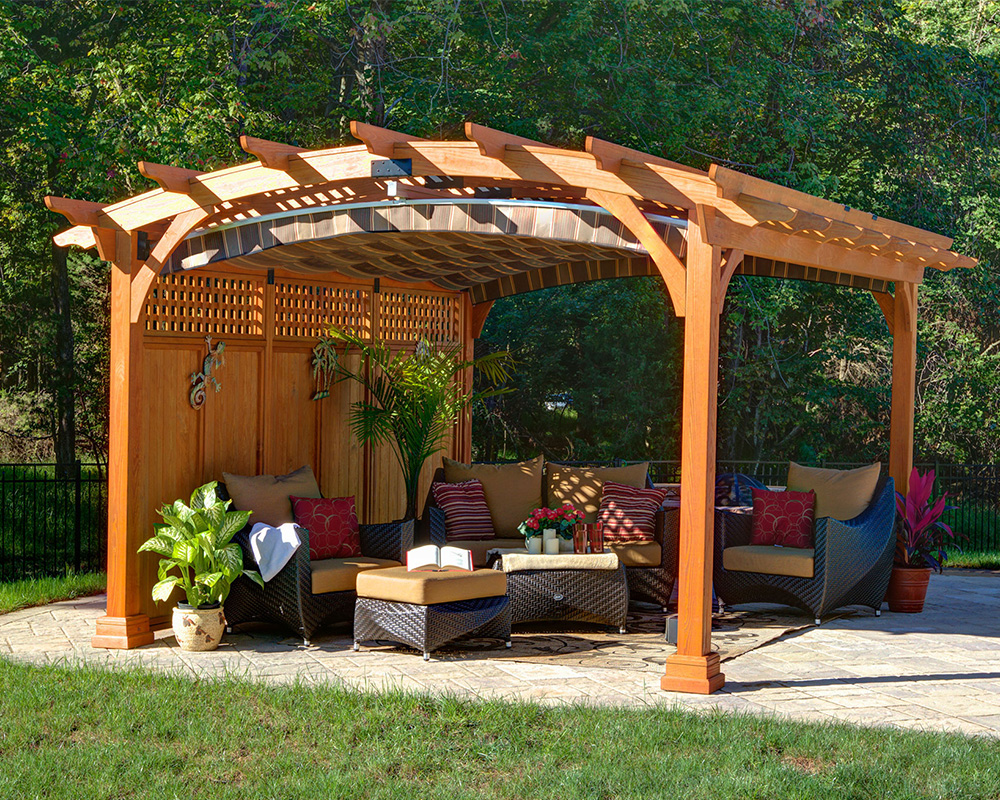
An arched pergola is a type of pergola that has an arch or series of arches across its top. This type of pergola can be used to create an inviting and elegant entrance to your home, or to provide shade and shelter in your garden. Arched pergolas are available in a variety of styles and sizes, so you can find one that suits the look of your home and garden.
Arched pergolas are made from a variety of materials, including wood, metal, and vinyl. They can be freestanding or attached to your house. If you choose an attached pergola, make sure it is securely anchored to avoid damage in case of high winds.
Arched pergolas add beauty and function to any outdoor space. With careful planning, you can create an inviting entrance to your home or add shade and shelter to your garden.
The Promenade Pergola
A promenade pergola is a type of pergola that is designed to be used as a walkway or promenade. Promenade pergolas are usually much larger than standard pergolas, and they often have decorative features such as latticework or carvings. Promenade pergolas can be made from a variety of materials, including wood, metal, and stone.
Promenade pergolas are a great way to add beauty and interest to any landscape. They can be used to create a dramatic walkway or simply provide a place for people to enjoy the outdoors. Promenade pergolas can be purchased ready-made or custom built to fit your specific needs. If you choose to have a promenade pergola built, be sure to work with a reputable contractor who has experience in this type of construction.
The Pitched Pergola
Pitched pergolas are a great way to add shade and protection from the elements to your outdoor space. They can also be used to create an outdoor living space or garden room. Pitched pergolas are typically made from wood, although they can also be made from metal or plastic. If you are considering adding a pitched pergola to your home, there are a few things you should keep in mind. First, you will need to decide where you would like to place your pergola. It is important to choose a location that receives enough sunlight and has good drainage. You will also need to make sure that the area is large enough to accommodate the size of the pergola you plan to build. Finally, you will need to obtain the necessary permits from your local zoning department. Once you have all of the necessary information, you can begin planning and building your pitched pergola.
The Many Benefits of Owning a Pergola
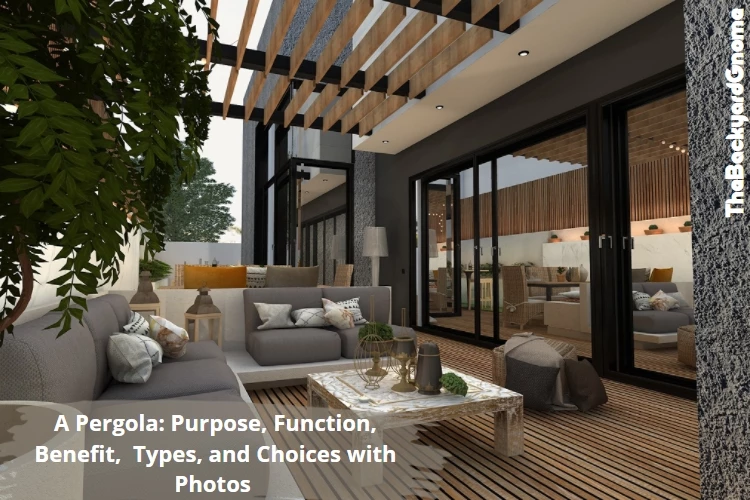
A pergola is a great addition to any home. Not only do they add beauty and value, but they also are a great way to enjoy your outdoor space. Here are just a few of the many benefits of owning a pergola:
- A pergola can provide shade on hot summer days.
- They can be a great place to entertain guests.
- Pergolas can increase the value of your home.
- They can provide privacy when you need it.
Pergolas are relatively easy to construct and maintain.
How to Install a Pergola in Your Backyard or Garden
If you're planning to add a pergola to your backyard or garden, here's what you need to know about installation.
| Step to Install a Pergola | Description |
| Choose the right location | The first step is to pick the right spot for your pergola. It should be in an area that gets plenty of sun and is away from any trees or other structures that could block its light. |
| Measure the area | Once you've chosen the perfect location, take some measurements so you know how much space you have to work with. |
| Choose your materials | There are a variety of materials you can use to build your pergola, including wood, metal, and vinyl. |
| Assemble the parts | Once you have all of your materials, it's time to start putting the pergola together. |
| Install the pergola | The final step is to install the pergola in your chosen location. |
| Enjoyment! | Installing a pergola in your backyard or garden can add both beauty and function to your home. With these tips, you'll be able to install yours with ease. |
The Best Ways to Use Your Pergola to Get the Most Out of It
There are a lot of ways that you can use your pergola to get the most out of it. Here are some of the best ways:
1. Use it as a sunshade
If you live in an area with a lot of sunshine, then you can use your pergola to create a shady spot to relax in. You can add a few comfortable chairs and even a table to create the perfect spot to enjoy the outdoors without having to worry about the sun beating down on you.
2. Use it as a garden feature
If you have a beautiful garden, then you can use your pergola to really show it off. By adding some climbing plants, you can create a stunning feature that will really make your garden stand out.
3. Use it as a party area
If you love to entertain, then you can use your pergola to create the perfect spot for parties and gatherings. You can add some outdoor furniture and even some lights to really make the space feel like a party area.
4. Use it as a quiet retreat
If you just want a place to relax and escape from the hustle and bustle of everyday life, then you can use your pergola to create a tranquil oasis. Just add some comfortable furniture and some calming decor and you will have the perfect spot to unwind and relax.
These are just a few of the best ways that you can use your pergola to get the most out of it. There are many other great ideas out there, so be sure to explore all of your options and find the perfect way to use your pergola. You will be glad that you did.
Pergolas Vs. Gazebos and Solariums
Still, there is some protection offered by the lattice or the open roof of the pergola itself, but there is usually plenty of sun coming in.
There are generally no walls, curtains, or netting surrounding a pergola; this is usually left to gazebos, solariums, and tents, to keep us fully separated from the elements.
Here's a picture of a typical gazebo for comparisons' sake. Notice that it has netting you can extend to enclose yourself, keeping you protected from bugs, sun, and whatnot.
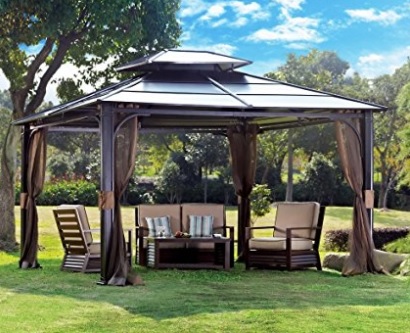
The other big difference here with a gazebo is the roof. Gazebos always have a roof over them of some sort, whether it's hard top or soft top, while pergolas do not.
That said both are still usually square-ish or rectangular in shape, it's just that a gazebo has a roof and a pergola doesn't.
Also, gazebos don't always have solid walls. Gazebos either have no wall between the struts, or a curtain or netting used to make a type of wall.
Some gazebos have solid walls. These exist, except the walls are made out of glass, and these structures are known as solariums, because they allow sunlight in, allowing for heat to collect inside, due to the walls and windows.
Here's a picture of a solarium, for reference.
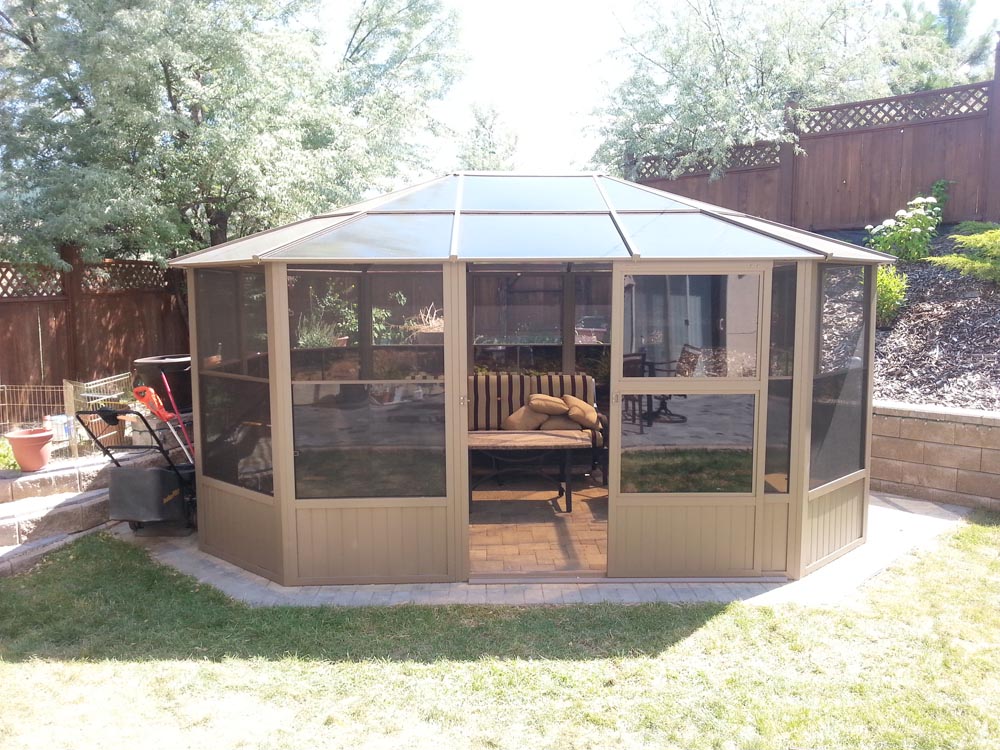
A solarium is similar to a gazebo, in that it has a roof, but it also has the solid walls, kind of like a little cottage, or enclosed room, but often with a distinct octagonal shape that gazebos do not usually have, and which pergolas never have.
Anyway, let's back to pergolas before we get too far off topic, as your average backyard can and often is filled with many structures, and we don't want to talk about *all* of them right now.
Consider this. Pergolas, while they are often freestanding, can also be attached to your home, and hence not freestanding in these particular cases.
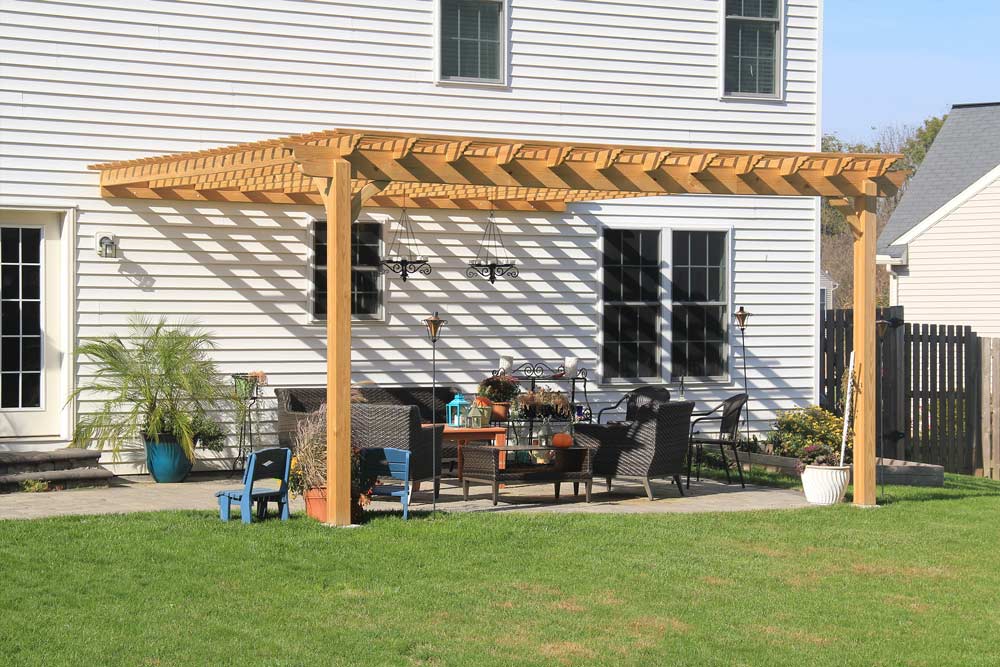
This is where the term "eave" *would* seem more applicable for pergolas, in that pergolas which extend off of a house seem to act as eaves unto themselves… except, ironically, that pergolas do not provide a solid covering like most eaves do.
That is, unless you add some covering in the form of plants or vines that is thick and protective.
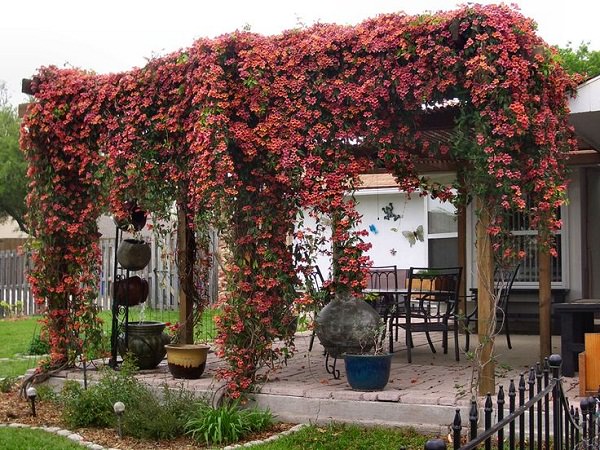
Now that you think you might have a handle on pergolas, behold! They can also act as a covering for a walkway, following a straight path that people may walk under, several abreast, like this one below…
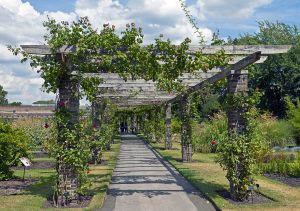
As you can see, something like this would not look out of place at a vineyard or some type of large garden. In the above example, there is a flowering bush which winds it's way up the brick pillars holding up the pergola and, in serpentine fashion, snakes around the crossbeams. It looks lovely and very rustic due to the type of brick and wood they've used to make it.
Now, below we have something similar, but not at all the same as the other long pergola we just saw. This one is long, but has a completely different look, and function.
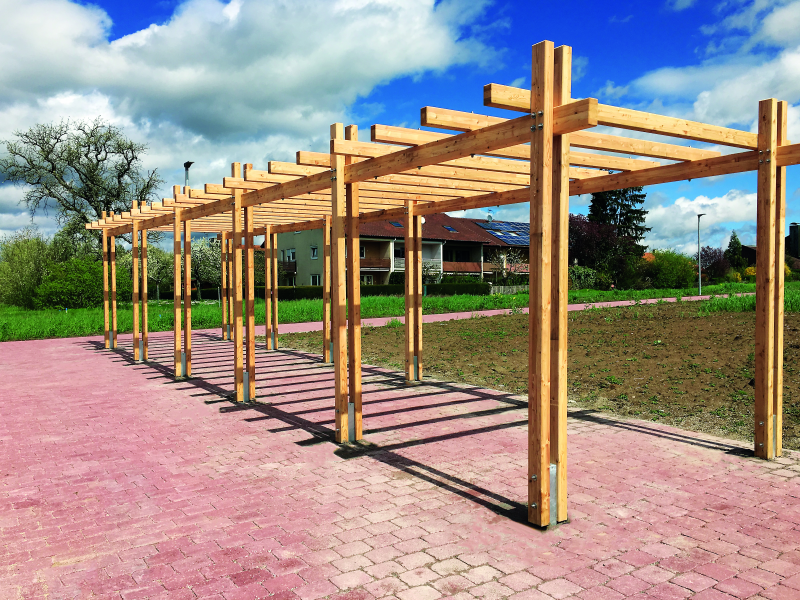
What might the function of this one be? It doesn't follow a walkway, or have any covering at all, or really any sort of design flair to make it more elegant.
There is nothing underneath it, nor does it look like a cozy getaway destination in your backyard. In fact, it seems to just be hanging out on its own, near a garden, but not in it, and with no particular purpose other than to be there.
Still, it is clearly a pergola, with its purpose a relative mystery.
Yes, it would seem that the more you know about pergolas, the more you should be prepared to be surprised, as there are practically unlimited types that you'll see out there once you start to be able to identify them.
Why, we haven't even mentioned arched pergolas yet. Here's one of those…oh, and it has it's own wall, thereby defying one of the "laws" of pergolas - no solid walls!

Pergolas Vs. Arbors
By now, you can probably see what the difference is between a pergola and a gazebo. But what about an arbor? Arbors look similar to pergolas in several ways, but they serve different purposes.
In fact, some even use the term arbor and pergola interchangeably. The gall of these people!
Here is a picture of your average arbor.
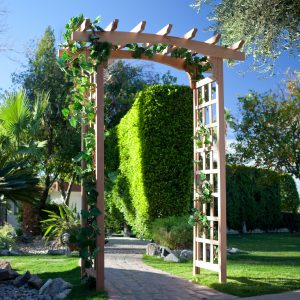
The etymology of the word arbor is interesting. In french, "arbre" means tree, and "erbier" means "grass" or "herb". In middle english, arbour means "lawn" or "flower bed".
And so, in terms of the history of the word, arbor has a very different meaning from "pergola", which means "outcropping eave".
In other words, pergola harkens to something protective, and arbor suggests vegetation, which is logical, as arbors are almost synonymous with gardens.
Physically, like a pergola, arbors are not enclosed, and they have at least four struts holding them up, and then crossbeams over top. They come in a variety of styles, and are made from a variety of materials, but usually they are made from wood.
However, unlike pergolas, you aren't encouraged to spend a lot of time under an arbor. It is meant to function almost like a doorway, or entrance / exit to or or from one part of your yard to another. Often it leads to or from a garden.
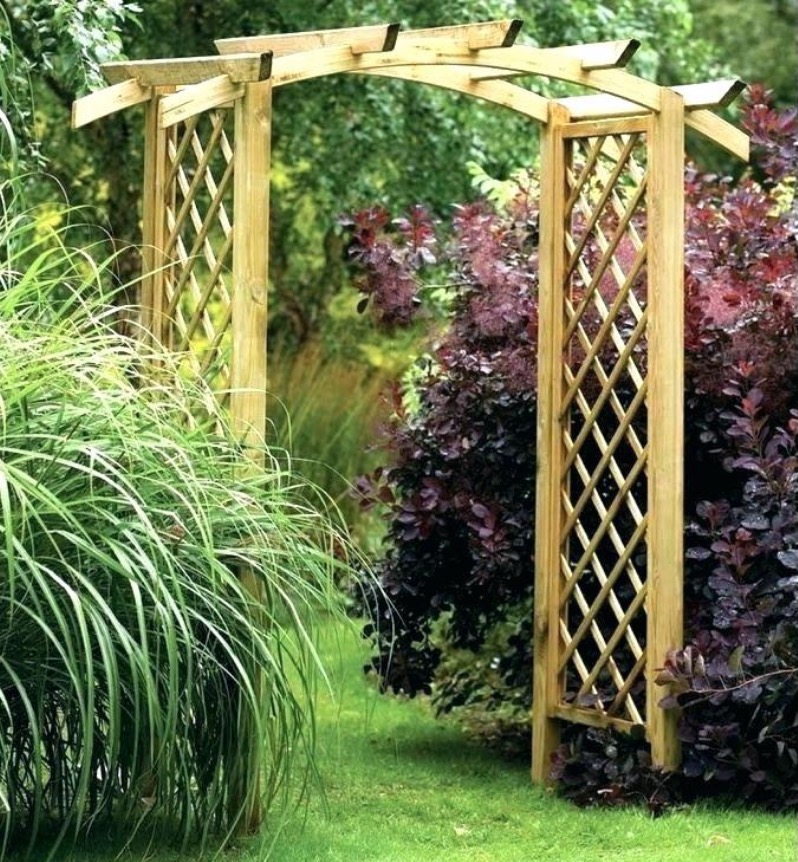
Still, arbors visually resemble pergolas more than gazebos do, as they are usually rectangular, open on all sides, and most often made out of wood.
But of course, there's always exceptions.
Don't look now, but here is a pergola which has circular pillars made from cement. It is free-standing, but still nestled up beside a house. It is also overflowing with vegetation. Still, you would not confuse this structure with an arbor.
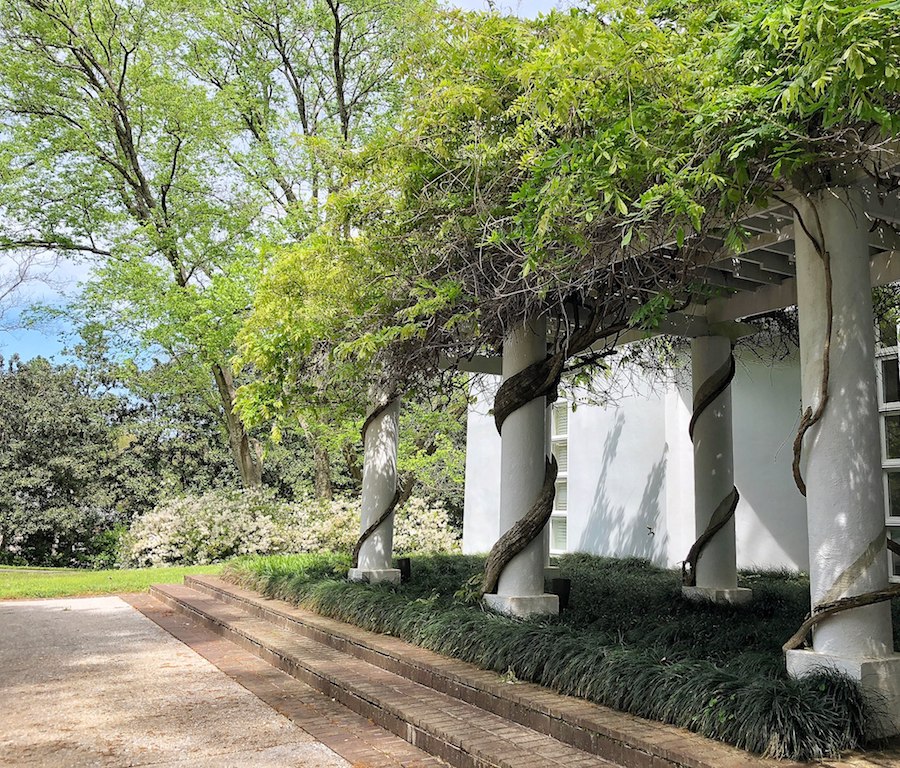
Speaking of defying expectations, here is an arbor made out of aluminum for comparisons' sake. It is, as you can see, not made from wood, and, also, rounded at the top, defying convention.
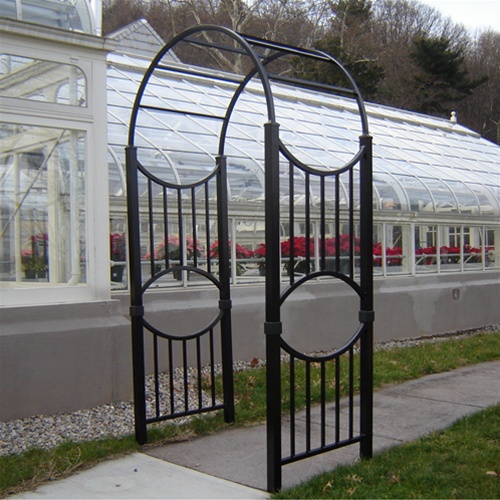
While arbors can be kept free of vegetation, they can also be a place to feature plants and flowers, just like certain pergolas. Take this arbor, for example.
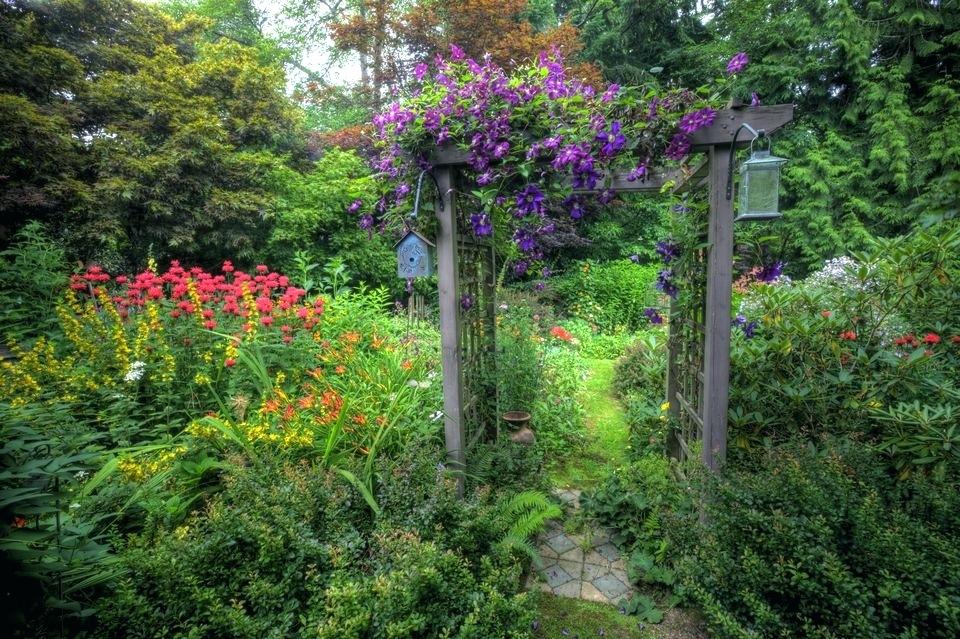
After looking at a few different arbors, you can see how arbors are not the same as pergolas.
Pergolas create a sitting area, arbors do not, so their function is different. Pergolas are much larger than arbors. Height-wise, they are comparable. Length-wise, they are very different. They both be highly ornate, or very simple, design-wise.
Conclusion (For Now…)
We hope that this article provides some useful information on pergolas, so that, if you didn't before, now you know what a pergola is and what it is used for.
We've provided what should prove to be the guidelines of what makes a pergola a pergola, but of course, rules are meant to be broken, so prepare to be shocked and amazed the more you look into them.
All in all, if you feel like we missed anything, or got something wrong, leave us a comment, as we'd love to hear from you all on this!
Related posts:
 |
 |
 |
 |

About Simmy Parker
Simmy is an outdoor expert who loves to spend time in the wilderness. She received a BS degree in Civil Engineering at Sacramento State University, and has put her skills to use by helping design and build some of the most impressive structures in the world. However, Simmy's true passion lies in sharing her love of nature with others, and she spends much of her free time leading hikes and teaching people about the flora and fauna that can be found all around them.
Thoughts on "What is a Pergola and What is It Used for?"
 |
 |
 |
 |
You can Get FREE Gifts. Receive Free Backyard Items here. Disable Ad Blocker to get them all now!
Once done, hit anything below
 |
 |
 |
 |